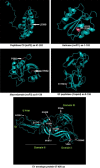Genetic characterization of 2006-2008 isolates of Chikungunya virus from Kerala, South India, by whole genome sequence analysis
- PMID: 19851853
- PMCID: PMC7088544
- DOI: 10.1007/s11262-009-0411-9
Genetic characterization of 2006-2008 isolates of Chikungunya virus from Kerala, South India, by whole genome sequence analysis
Abstract
Chikungunya virus (CHIKV), a positive-stranded alphavirus, causes epidemic febrile infections characterized by severe and prolonged arthralgia. In the present study, six CHIKV isolates (2006 RGCB03, RGCB05; 2007 RGCB80, RGCB120; 2008 RGCB355, RGCB356) from three consecutive Chikungunya outbreaks in Kerala, South India, were analyzed for genetic variations by sequencing the 11798 bp whole genome of the virus. A total of 37 novel mutations were identified and they were predominant in the 2007 and 2008 isolates among the six isolates studied. The previously identified E1 A226V critical mutation, which enhances mosquito adaptability, was present in the 2007 and 2008 samples. An important observation was the presence of two coding region substitutions, leading to nsP2 L539S and E2 K252Q change. These were identified in three isolates (2007 RGCB80 and RGCB120; 2008 RGCB355) by full-genome analysis, and also in 13 of the 31 additional samples (42%), obtained from various parts of the state, by sequencing the corresponding genomic regions. These mutations showed 100% co-occurrence in all these samples. In phylogenetic analysis, formation of a new genetic clade by these isolates within the East, Central and South African (ECSA) genotypes was observed. Homology modeling followed by mapping revealed that at least 20 of the identified mutations fall into functionally significant domains of the viral proteins and are predicted to affect protein structure. Eighteen of the identified mutations in structural proteins, including the E2 K252Q change, are predicted to disrupt T-cell epitope immunogenicity. Our study reveals that CHIK virus with novel genetic changes were present in the severe Chikungunya outbreaks in 2007 and 2008 in South India.
Figures




References
-
- Schuffenecker I, Iteman I, Michault A, Murri S, Frangeul L, Vaney MC, Lavenir R, Pardigon N, Reynes JM, Pettinelli F, Biscornet L, Diancourt L, Michel S, Duquerroy S, Guigon G, Frenkiel MP, Brehin AC, Cubito N, Despres P, Kunst F, Rey FA, Zeller H, Brisse S. PLoS Med. 2006;3:e263. doi: 10.1371/journal.pmed.0030263. - DOI - PMC - PubMed
Publication types
MeSH terms
Substances
LinkOut - more resources
Full Text Sources
Other Literature Sources
Medical

